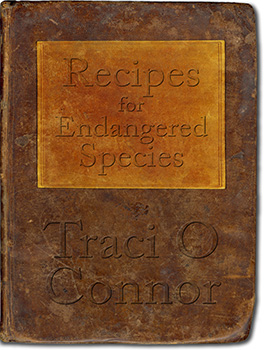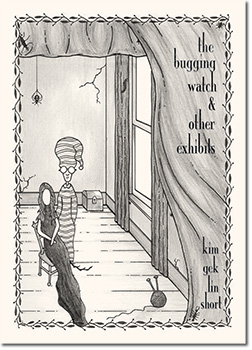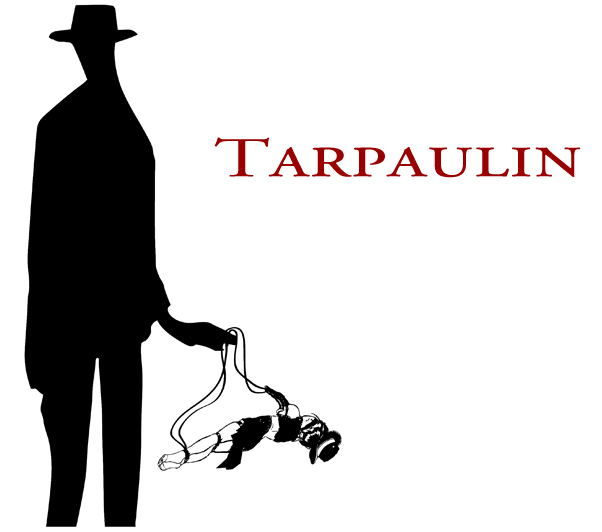A dark water into which the light descends only a short distance, vestigial gill-slits emerge as the fluid colloid pours in. A luminous, liquid night. Underwater, one can think and dream. All our aqueous history laid out on the sea-floor. In the emulsified dusk, one can see the strings of a violin held down by eel-like pinkies. One can travel, one can go.- from "Interview (Who is Asking / Who is Answering)" in The Book of Jon
Quick jump to authors: Jenny Boully | Ana Bozicevic | Traci O. Connor | Mark Cunningham | Claire Donato | Danielle Dutton | Sarah Goldstein | Johannes Göransson | Noah Eli Gordon and Joshua Marie Wilkinson | Gordon Massman | Joyelle McSweeney | Joanna Ruocco | Kim Gek Lin Short | Shelly Taylor | Max Winter | david wolach | Andrew Zornoza
30 January 2010
Eleni Sikelianos, Poet-In-Residence at Flatmancrooked
29 January 2010
Pre-Order & Save: Traci O Connor's _ Recipes for Endangered Species _
These deftly written stories rear and buck against the confines of the traditional story collection, bursting out in images and recipes, galloping back and forth between traditional paragraphs and alternate forms. . . . Even though you’re moving fast enough that you could end up anywhere, Connor’s thought about every single word, every gesture, and she can turn each story on a dime. This is a marvelous debut.—Brian EvensonTraci O Connor’s subject matter is never easy. Her work cuts to the core, exposing cultural taboos and psychic turmoil. Her use of the fantastic emerges organically from her material, compelling the reader to face her own fears and prejudices, to embrace the monstrous within herself, to live with greater curiosity and compassion.—Melanie Rae Thon
25 January 2010
Pre-Order and Save: Kim Gek Lin Short's The Bugging Watch & Other Exhibits
The Bugging Watch & Other Exhibits
Tarpaulin Sky Press
ISBN: 9780982541616
Fiction/Poetry | 5"x7", 74 pp, pbk |May 2010
Cover art by Daniel Rhodes
Click here for more info, a larger cover image, and excerpts from the book.
Special pre-order price: $12 includes shipping
(vs. $18, later, at Amazon)
Click here to pre-order by check.
Or pre-order with PayPal (Ships May 2010):
The Bugging Watch & Other Exhibits is the prose elegy of a boy who wants to be a bug in order to save by symbiosis the dead girl he loves. Can Harlan, in “the basement forever inside him,” conjure Toland back from “the scars of Monday”? Enacted in prose poems and cross-referenced datebooks, the inseparable lovers, Harlan and Toland, eternally rehearse for a real life together, repeating in that instant between being and nonbeing, the loss into which their love escaped.
A strange romance of “the secret motions of things” (Francis Bacon, The New Atlantis, 1627), Kim Gek Lin Short’s The Bugging Watch and Other Exhibits is an exciting, mysterious, sometimes macabre new narrative. Her zany futuristic gothic opera of prose poems is threaded with magic, potions, passion, a “concert of hair,” a “hazmat of holes.” With its incantations of quantum teleology, its footnotes & sources, it is a magnificent work. Irresistible!
—Norma Cole
This small unsettling book first proposes a stiflingly sweet symbiosis between two shut-in innamorati, and then lets its queer world subdivide in a theater of exfoliating roles. Most shocking in this miniature is the Rosebud at its center, a muse who breaks with her mate only to reinvent him out of bugs, ink and sugarwater. Like a Victorian photo collage mounting, say, the head of Prince Albert on a croquet mallet or umbrella handle, this seemingly innocuous work both conceals and reveals its morbidity, its twisted thirsts.About the Author
—Joyelle McSweeney
Kim Gek Lin Short is the author of The Bugging Watch & Other Exhibits (Tarpaulin Sky Press, 2010) and China Cowboy (forthcoming from Tarpaulin Sky Press, 2011, as well as two chapbooks, The Residents (dancing girl press) and Run (Rope-a-Dope). She lives in Philadelphia with her husband and daughter.
Work from The Bugging Watch & Other Exhibits was first published in Caketrain Journal, Drunken Boat, 42 Opus, Mad Poet’s Review, No Tell Motel, Shattered Wig Review, SoMa Literary Review, Tarpaulin Sky and Wicked Alice. “The Exhibits” was published as a chapbook entitled The Residents (dancing girl press). Parts of “The Bugging Watch” section were published in the anthology narrative (dis)continuities: prose experiments by younger american writers (Recycled Karma Press).
Recently Received
 Most of the titles below are available for review, though we include the friend copies and the purchased copies as well, thinking we can probably scare up another copy if you're interested in reviewing one for TSky.
Most of the titles below are available for review, though we include the friend copies and the purchased copies as well, thinking we can probably scare up another copy if you're interested in reviewing one for TSky.
Titles marked with asterisks are hand-bound books or are otherwise special editions and are limited, if still available at all.
* Juliet Cook, Fondant Pig Angst (Slash Pine Press, 2009)
Denver Quarterly, Vol. 44. No. 2, 2010
Fence Vol, 12. No. 2, Fall/Winter 2009-10 Sandy Florian, Prelude to Air from Water (Elixir Press, 2010)
Sandy Florian, Prelude to Air from Water (Elixir Press, 2010)
Prelude to Air from Water, our readers will be delighted to know, includes the entirety of the text of Florian's sold-out chapbook from Tarpaulin Sky Press, 32 Pedals & 47 Stops.
Claire Hero, Sing, Mongrel (Noemi Press, 2009)
Brenda Iijima, If Not Metaphoric (Ahsahta Press, 2010)
Kristen Kosmas, Hello Failure (Ugly Duckling Presse, 2009)
Alex Stein, Made-Up Interviews with Imaginary Artists (Ugly Duckling Presse, 2009) Mathias Svalina, Destruction Myth (Cleveland State University Poetry Center, 2010)
Mathias Svalina, Destruction Myth (Cleveland State University Poetry Center, 2010)
Allison Titus, Sum of Every Lost Ship (Cleveland State University Poetry Center, 2010)
J.A. Tyler, Inconceivable Wilson (Scrambler Books, 2009)
Kevin Varrone, g-point almanac: passyunk lost (Ugly Duckling Presse, 2010)
Peter Waterhouse, Language Death Night Outside. Poem. Novel. Translated by Rosmarie Waldrop (Burning Deck, 2009)
20 January 2010
TSky Investigates: FOURSQUARE Editions
FOURSQUARE Editions, a branch of Outside Voices Press, is a literary publication printed on single, 8"x8" sheet which folds up to 4"x4"and is housed in a screen printed and embroidered fabric sleeve. Each issue contains four poems by women writers and one image by a woman artist. Jessica Smith, editor of FOURSQUARE Editions, was kind enough to talk about how and why this beautiful periodical was created.
What was your inspiration for FOURSQUARE's design, size, sleeves, etc?
Jessica: I wanted to incorporate screen printed fabric that hadn't been mass-produced into the design of a periodical dedicated to bringing together women from various artistic backgrounds (visual art, fabric design, poetry). I also wanted to pay homage to the crafts of sewing and embroidery which have been considered women's arts, "folk arts," "cottage industries,"--that is, of lesser value than whatever "men's arts" might be.
When FOURSQUARE was brewing, I was living at home, having taken a semester off of my PhD program, and was in the realm of fabric, embroidery, and the handmade. My parents both work or have worked in the clothing industry. My dad sells uniforms and my mom used to make children's clothes, and I wanted to involve my parents in the project. I also wanted to make use of my dad's huge embroidery machine, which is what makes the embroidered "FOURSQUARE" on the front of the sleeves.
The folded interior of FOURSQUARE grew out of discussions with my friend Maureen Thorson of Big Game Books, who makes "tinysides." These small chapbooks are usually under 3"x5" in size and are made from a single sheet, or broadside, folded to make multiple pages and bound along one side. To make poetry objects small and folded was kind of a Mid-Atlantic zeitgeist at the time, although Maureen's design for tinysides is more advanced than mine for FOURSQUARE. She takes multiple page sizes into account and must fold accordingly, where I make authors conform to a particular size requirement. The way the poems are arranged and which poems are chosen to work together in an issue, aims to influence the way the poems are read. There is an interplay that is more obvious than in a magazine where the authors' works are separated by pages.
What is the poetic and art aesthetic of FOURSQUARE?
Jessica: The idea was to bring together female artists and poets, with an emphasis on ones that were emerging and/or visual. I wanted to show my female poet friends, especially the visual poets, what my female artist friends were doing, and vice-versa. I think more collaboration between poets and artists would be fruitful-- would make "visual poetry" more informed, would provide more interesting words in visual art that uses them.
FOURSQUARE is a women's magazine. It is edited, made, and populated by women. In its pages I wanted to create a safe place for women to "play." There has been much discussion about gender equality in poetry and especially with regard to editorial policies. When I edited the magazine (name) before FOURSQUARE, it was hard to get women to "submit." I hoped that if I created a publication that was safe space for women, they would be more likely to send me poetry. I think it worked, but not in the way I expected. I expected to solicit submissions, when what has actually happened is that people who are in FOURSQUARE share their extra copies with friends, who then submit, or encourage their friends to submit. It has become more like a small network than a free-for-all of blind submissions.
Several authors have appeared in Tarpaulin Sky publications as well as in FOURSQUARE-- Jenny Boully (FOURSQUARE 1.2), Brenda Iijima (1.2 and Special Edition), Juliana Spahr (1.2), Jane Sprague (1.6), Amy King (1.8), Jen Tynes (1.11), Ada Limon (2.8), and Michelle Naka Pierce (3.1). What about these authors' work speaks to you as an editor, reader, writer?
Jessica: To make a broad generalization, what I like is that many of these poets mix genres. I am a poet who enjoys exploring the interrelationship of nacheinander and nebeneinander, and appreciate other poets who mix language and visual art like Brenda Iijima and Michelle Naka Pierce do, or poetry and the essay, like Jenny Boully and Juliana Spahr do. Although I support, encourage, and admire experimentation, I do not like experimentation for its own sake. Each of these poets seems to cross formal boundaries because the poetry's content requires it.
To concentrate on Boully's [one love affair]* for a moment, I enjoy the blend of journalistic self-expression and self-evaluation, academic references, prose poetry and essay-like prose (as the best essays are often "poetic"); the Wallace-esque hypertextuality of reading the text and its endnotes, the Duras-like sensuality of language, and the production values of the book itself.
FOURSQUARE is a home for short poems, do short poems speak to you differently than longer poems do?
Jessica: Indeed. I have a short attention span and am a busy person. I want a poem to do something for me quickly. I am not good at "getting lost in a book." Instead, I like to think of a singular project or point that a poem is making. I like to dwell on such a point for a long time-- months, years--rather than spend months or years reading a book. I enjoy the life of the mind, but I like to be in control of it. When I'm reading, the author is in control of me--I have to pay attention to what s/he is saying and I have to physically be sitting in front of the book. I would rather be cut loose to think on my own. This is one reason that poetry appeals to me as a genre-- it is often shorter than novels or plays and I don't have to follow the plot so much as I have to think of the aesthetics and what is at stake in terms of form/content.

Although it may be small, FOURSQUARE sets out to accomplish a lot and does. Thoughtfully, it showcases the short poem, creates a safe space for women writers and artists to play, incorporates sewing and embroidery, utilizes fabric, and creates a dialogue between arts. The amount of time, thought and love that goes into FOURSQUARE is evident.
For more information on FOURSQUARE Editions visit: http://looktouch.com/press/
08 January 2010
New from Interbirth Books: Richard Owens's _ Embankments _

Richard Owens
Embankments
Interbirth Books 2010
5.0625" x 7.375", 43 pp.
$15 (w/free shipping in the US)
Seventy-five books (twenty-six of which are lettered A through Z) were designed, printed, assembled, and hand bound 100% in-house by Micah Robbins and Clifton Riley at Interbirth Books. The stitch is a buttonhole. The cover is an original screen / litho print.
If you've never held an Interbirth book in yours hands, you owe it to yourself to buy one. These beauties should cost about 5 times what they do, but Micah and Clifton, being great guys, insist on making high-end books available to low-end incomes.
Keep on the lookout, too, for Interbirth's upcoming projects, which include Diane di Prima's Loba Desesperada, and TSky Press publisher Christian Peet's Pluto: Never Forget (Book 2 of The Nines).
You can keep tabs on all things Interbirth--including the next issue of their handbound-plus-online magazine, Inter--by visiting their newly-redesigned website, interbirthbooks.com
Blake Butler Interviews TSky Press Author Andrew Zornoza at Bookslut
 Bookslut starts 2010 right, with Blake Butler interviewing Andrew Zornoza, regarding Andrew's debut with TSky Press, Where I Stay, as well as a host of other things, from Chris Farley to Superman to Susan Sontag. Some excerpts:
Bookslut starts 2010 right, with Blake Butler interviewing Andrew Zornoza, regarding Andrew's debut with TSky Press, Where I Stay, as well as a host of other things, from Chris Farley to Superman to Susan Sontag. Some excerpts:
You can set out to write something original, “make it new, make it new,” as Frederic Tuten now says channeling Ezra Pound... that mantra spanned those generations influencing each other in New York and Paris -- Queneau, Resnais, Robbe-Grillet, Ashbery, Harry Matthews. The problem is, you can set out to make something new every moment of your life and still end up with a handful of sand. . . .
I am not a big believer in intelligence. It's not one of my goals, matching brains with my reader. I'm more interested in feelings, though that's not quite the right word for it. I'm interested in new feelings that haven’t been mythologized yet, I'm trying to get as high and bent as possible. I can over-intellectualize after the fact, but in the moment, when I'm sitting in front of that computer, all that is far away, everything is far away. . . .
Have I taken a lot of drugs? Yes. But there's no reason why anybody can't splinter their observational powers to be able to see multiple states of the same evolving moment. As long as you can get to some nexus, some original state . . . you can leave the constraints of being a static observer. I have students now, somehow, and they always want to find their voice. It's very important to them. And they want to write honestly. That seems completely bonkers to me. You mean, you only have one voice? Aren't we all more complicated than that? And you still believe in some sort of truth? The truth to what? We're a hundred years past modernism here and sixty-five past the Holocaust. What's honest? That people are awful? That evil exists? That men abuse their wives and mothers die of cancer? Of course. If we could get past our vicarious thrill of seeing the same dramas enacted over and over maybe we'd progress a little bit. . . .
The photography was difficult. Where I Stay is a complete work of fiction. Except, I took the photos. So, it's all completely true. I was there, some of these people are dead. The geography is there, but it's temporarily covered with Walmarts and Starbucks.
READ THE ENTIRE INTERVIEW HERE







